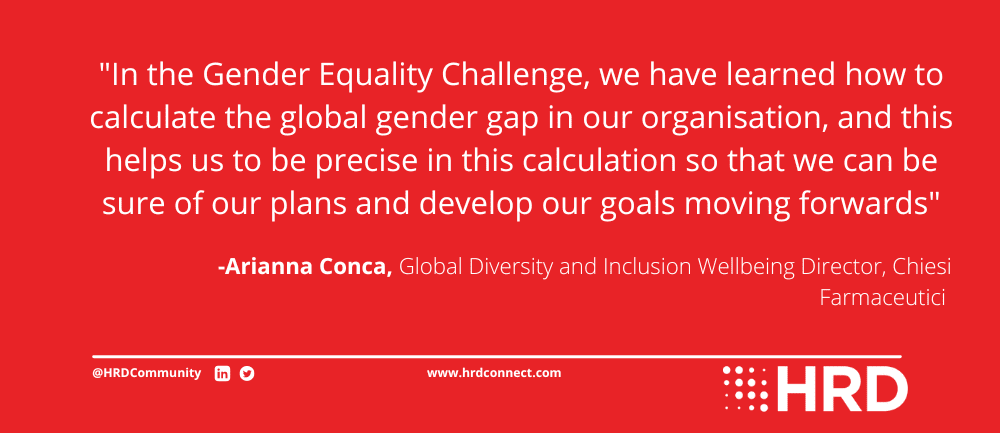-
Provided by

- Date published: Nov 1, 2022
- Categories
We all know that having a robust DEI policy is a given – but for a dispersed, global multinational, making it an inherent part of the culture is an altogether tougher remit. Yet that is exactly what Chiesi Group has managed to achieve under the nurturing guidance of its Global Diversity and Inclusion Wellbeing Manager, Arianna Conca and her dedicated team.
To provide a little perspective of the scale of the task at hand, the organization – founded in Parma, Italy in 1935 – counts over 30 affiliates in countries including Italy, the US, China, Australia, Canada, Brazil and the UK. It has an employee base of over 6,000 and provides medicines to patients in 90 nations. With such a blend of cultures, languages, genders, ages and socioeconomic demographics, creating policies, practices and plans around these groups is no mean feat.
A fresh take on inclusivity
A year ago, Chiesi decided to further strengthen its corporate values and the practical behaviours needed to illustrate them on a daily basis by updating its inclusivity strategy: “We wanted different dimensions: gender, sexual orientation, disability, different generations, and also invisible diversities such as personal style, lifestyle, and mindset. We wanted to be able to include all these diversities to ensure that we are truly diverse,” says Conca.
The DEI policy also needed to be scaled up across multiple affiliates in order to embed it into common practices and make it part of the Chiesi DNA: “The combination of local and global, representing all the organisation in different senses and being able to reach all the levels and working parts was a big challenge. We had to ask ourselves: how can we reach all the people, the geographies, all the diversities, all the ways of thinking, all the different situations?” she explains.

B Corp responsibilities
Another driver for the Chiesi People team and the organisation as a whole in deciding to reinforce its DEI policies was the decision to become a Benefit Corporation (B Corp) back in 2019. This certification requires achieving a score of 80 or more in a stringent social and environmental performance assessment and needs to be re-certified every three years meaning that businesses must continually maintain strict practices in order to re-qualify.
Creating the Dream Team
To drive forwards the new direction the company was headed, Conca formed a direct team; a small but diverse group (comprising men and women, three from Gen X, one from Gen Z, LGBTQ+, and a person with disabilities) to work with her on planning the new DEI policies. On top of that, she also worked with different temporary (or functional) teams to lead specific D&I projects, in order to be sure to take on different perspectives and ideas.
Together they created a blueprint of how to make inclusivity a part of the everyday working culture: “We didn’t have any structured programmes around gender or DEI in general at Chiesi, so the mission was to create a governance that worked and could be rolled out globally across the affiliates. This is why we created a dedicated department – my department – but it was also the reason we decided to set up a diversity and inclusion committee,” she explains.

Employee-driven policies
The impetus behind forming The Chiesi Global DEI Committee came very much from the idea of listening to people to inform policy. Nothing here is created in isolation instead, a diverse committee of 16 employees; half women, half men and sixty per cent of whom come from different areas of the business and from different affiliates have the responsibility of defining the company’s global DEI plans.
“Their initial task was to define the Chiesi DEI profile; a multi-lateral plan that considers the impact on culture and infrastructure. From that we created a training plan that any people processes are assessed against before being worked around the KPIs,” she explains. “This is our process.”
A mouthpiece for change
Another channel the team wanted to see implemented in the burgeoning Chiesi DEI culture was an employee resource group (ERG) dubbed The Chiesi Affinity Network made up of volunteers and colleagues who want to contribute to the over-arching DEI strategy. “I’m very proud that we created this because we aren’t working on diversity and inclusion from a top-down approach but instead, we take our people’s ideas and proposals and use them to inform our policies. I always say that inclusion is made of inclusion, so of course, we need their ideas as equal input into our plans,” she adds.
To this end, those interested in contributing are essentially given a mouthpiece to speak up about any issues they feel are pertinent: “They can nominate a leader and meet during the working day to reduce the impact on their free time. The company supports their activities and if they have suggestions, we evaluate them and decide which ones we can implement,” says Conca.

Kicking gender parity into touch
Alongside the seismic shift towards a global DEI-infused culture, the ‘equity’ part has taken on a life of its own since the team put a new system in place to identify any gaps throughout the organisation. It has helped renew the focus on areas like training, internal mobility schemes and onboarding and recruitment to ensure they hit their DEI targets.
“In the Gender Equality Challenge, we have learned how to calculate the global gender gap in our organisation, and this helps us to be precise in this calculation so that we can be sure of our plans and develop our goals moving forwards,” she says.
“We are proud of the metadata that we are gathering. The method is very analytical using both qualitative and quantitative analysis it is based on two different dimensions: equal pay, and equal opportunities. We have a global plan made up of 18 actions that we are delivering over the next few years. One of those has been to challenge ourselves and all our people, and processes to assess whether they are influenced by bias. This covers recruitment, people development, performance evaluation and salary review. Now we have the results of these processes and can see areas we need to focus on, and we are at the point where we can act on things we want to improve to be sure that our processes are free of bias and that we can make all our people aware of possible bias,” she explains.
The team has also created a global and local training plan which covers inclusive leadership and unconscious bias and this year they have decided to focus on inclusive language: “We think that this is the key to respect and openness to others’ perspectives and the very basis for inclusion,” says Conca.
Anchoring diversity in recruitment
While the team has always had a firm focus on diversity and inclusion across all its recruitment channels, the team has fine-tuned its global recruitment policy, ensuring that attention to DEI is specified in all elements of the process. This covers gender balance in the pipeline of candidates, so the same number of men and women are selected, with a specific focus on leadership positions and having gender-balanced interviewers.
“One of our recent projects was looking at talent acquisition and recruitment and we had the opportunity to interview many people from our affiliates which allowed us to discover some important practices in talent acquisition. So now, when we have a vacancy, we open the positions on specific platforms that are dedicated to LGBTQ+, or people with disabilities, specifically for women etc., to be sure that we are contacting all of the less represented groups,” she explains.
She also adds that collaborating with networks outside of Chiesi is imperative to understanding the broader issues around gender and diversity, and learning from the wider HR business community, collaborating and networking to keep abreast of the methods to improve her own practices at Chiesi.
“Whenever you work on diversity and inclusion, it’s very important to have a benchmark and to listen to other people and what their organisations are doing and learn from others’ experiences. Sometimes we look for help or support from possible global partners that can teach us to deliver projects or establish some guidelines. We are also part of various informal networks where we exchange practices with other companies, normally multinationals, but not necessarily from the pharmaceutical field,” she adds.
Impacting the bottom line
Conca concedes that it’s not always possible to measure the financial impact of her DEI initiatives but that the benefits on the company culture are priceless: “A sense of belonging and engagement, performance; business results in terms of creativity, innovation and solutions are all benefits. In other words, the impact we would like to have, and our measure of success is the courage to be authentic, and acceptance of the coexistence of differences rather than simply talking about inclusion,” she says. “We want to see a positive impact on the individual; the team in which they work and the whole organisation and its performance.
The future is inclusive
While the DEI strategy is still in its growth phase as the blueprint is rolled out to the affiliate’s people teams across the globe, the culture that Conca and her team are so dedicated to creating is starting to become embedded in the organisation: “We can now see how this will enrich our business, increase our capacity for innovation, ensure a greater possibility of attraction and retention and, most importantly, ensure an enhanced level of empathy towards our main stakeholders, and our patients!” she says.
“We have defined many KPIs in our organisation that deal with the gender pay gap, for example, the number of men and women in leadership positions, in the hiring and promotion within our company. We have defined an HR analytics model to be sure that we control all the different dimensions that are dealing with DEI and its economic impact. It’s a very important stream and being able to integrate inclusion with our business objectives is one of the next activities that we are focusing on. We’ve started to create the right mindset, so the next step will be how it can truly impact business results,” she explains.
Conca uses an interesting analogy, to sum up, her own view on DEI and one she is committed to embedding at every touchpoint at Chiesi: “I like to describe inclusion as polarised glasses: they eliminate the superficial and make the colours of reality more vivid and give the possibility for reality to express itself in a very authentic way with all its colours and diversities,” she concludes.
